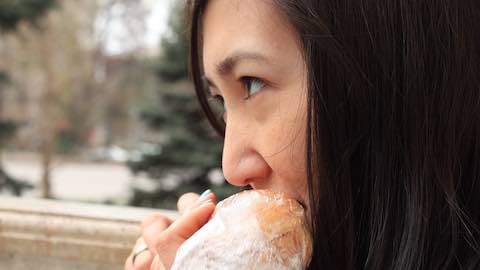- MENU
- HOME
- SEARCH
- WORLD
- MAIN
- AFRICA
- ASIA
- BALKANS
- EUROPE
- LATIN AMERICA
- MIDDLE EAST
- United Kingdom
- United States
- Argentina
- Australia
- Austria
- Benelux
- Brazil
- Canada
- China
- France
- Germany
- Greece
- Hungary
- India
- Indonesia
- Ireland
- Israel
- Italy
- Japan
- Korea
- Mexico
- New Zealand
- Pakistan
- Philippines
- Poland
- Russia
- South Africa
- Spain
- Taiwan
- Turkey
- USA
- BUSINESS
- WEALTH
- STOCKS
- TECH
- HEALTH
- LIFESTYLE
- ENTERTAINMENT
- SPORTS
- RSS
- iHaveNet.com: Recipes
By Stacey Colino

The crackers in your cupboard are stamped "Best before September 1, 2010." The "Sell by" date on the cheese at the supermarket is tomorrow. There's a yogurt in your fridge with today's date on it and an opened jar of mustard that's been there since the Bush administration. With all the talk about food safety nowadays, you're probably wondering what an expiration date really means -- and whether the foods they mark are safe to eat.
Believe it or not, these labels don't have standard definitions. What's more, many of them "have to do with the quality of the food, not necessarily the safety of the food," explains Joy Dubost, who has a doctorate in food science and is a registered dietitian in Washington, D.C. Here's the scoop:
"Sell by"
Don't toss that yogurt just yet! This date was designed so grocers know when to rotate their products. Generally, with proper refrigeration and handling, it's safe to use meats up to three days beyond the "Sell by" date, and dairy products within five days of the date. (With yogurt, which contains healthy bacteria, you can push the date by a week.)
"Best by" or "Best before"
This one's up to your personal taste, so to speak. These dates have to do with the quality of the food, in terms of its taste, smell, look, feel and texture. There's minimal risk to eating a food after these dates, but it may be a little stale.
"Use by"
"Take this one literally because with perishable products, safety and spoilage really are a concern," advises Jennifer McEntire, who has a doctorate in food science and is a senior staff scientist and director of science and technology projects at the Institute of Food Technologists. This date really does have to do with both the quality of the food and safety issues.
No date
Let your nose and taste buds be your guide if there's no date stamped on a product -- provided the can or box is not ripped, dented or compromised in some way. If it is, don't use it.
As for leftovers and other foods that you've already opened, consider these guidelines:
Leftovers
For your stomach's sake, use them or toss them within three days, and make sure to heat them thoroughly (ideally to 165 F) before consuming them, advises McEntire.
Condiments
Mustard and ketchup are very stable because they're acidic, so they can typically last up to a year after they've been opened. Salad dressings are also acidic, but because they contain oils and other ingredients that can turn rancid and produce off-flavors pretty quickly, it's best to use them within three months of opening, Dubost says.
Peanut butter and jelly
Jellies and jams will generally keep for up to nine months, especially if you don't double-dip. But if you're going to dip and re-dip the same knife into a jar, change it more quickly because you might introduce food particles or bacteria into it, advises McEntire. Because of the high oil content, peanut butter may not last as long. If it doesn't pass the sniff- and/or taste-test, you're better off tossing it.
Finally, to get the greatest longevity from the foods in your fridge, install a thermometer and keep the temperature at 40 degrees or below.
"And if you're ever in doubt about the safety of a food," says McEntire, "throw it out. It's better to be safe than sorry."
Subscribe to Receive our Gourmet Recipes
FOOD, DRINK & RECIPES [...]
APPETIZERS | SOUPS | PASTA | SALADS | MAIN COURSES | SEAFOOD | CHICKEN | PORK | LAMB | BEEF / VEAL | VEGETARIAN | SIDE DISHES | DESSERT | HEALTHY | WOLFGANG PUCK
Healthy Eating - Is Your Lunch Safe to Eat?
World-renowned chefs with an extraordinary passion for food share their passion on iHaveNet.com. These chefs make great cooking easier than imagined. Each gourmet recipe features expert advice and an easy-to-make recipe. Exactly what you need to transform your home cooking from acceptable to delectable
Article: Copyright ©